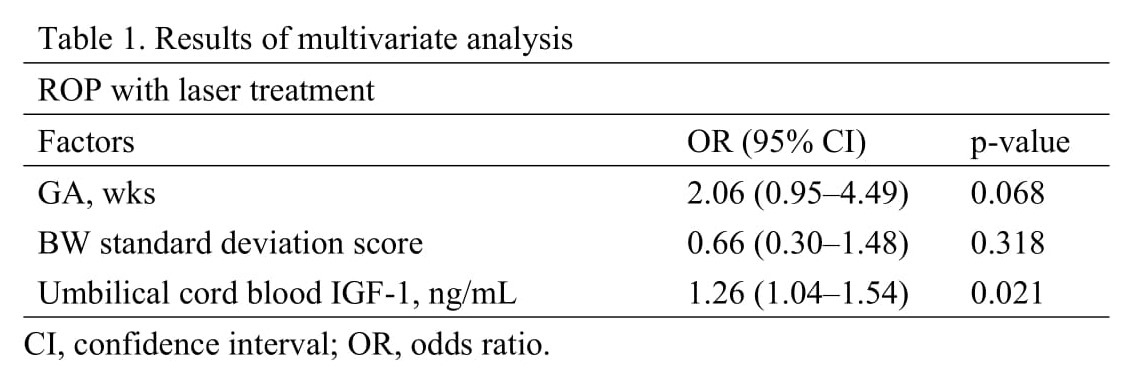Neonatal General
Category: Abstract Submission
Neonatology General 7: ROP - Endocrine
439 - Umbilical cord insulin-like growth factor-1 and retinopathy of prematurity in extremely preterm infants
Friday, April 22, 2022
6:15 PM - 8:45 PM US MT
Poster Number: 439
Publication Number: 439.137
Publication Number: 439.137
Nobuhiko Nagano, Department of Pediatrics and Child Health, Nihon University School of Medicine, Tokyo, Tokyo, Japan; Daichi Katayama, Department of Pediatrics and Child Health, Nihon University School of Medicine, Toky, tokyo, Tokyo, Japan; Koichiro Hara, nihon university itabashi hospital, itabashi, Tokyo, Japan; Takuya Akimoto, 日本大学医学部附属板橋病院, Itabashi, Tokyo, Japan; Takayuki Imaizumi, Department of Pediatrics and Child Health, Nihon University School of Medicine,, Itabashi-ku, Tokyo, Japan; Ayako Seimiya, Department of Pediatrics and Child Health, Nihon University School of Medicine, Itabashi-ku, Tokyo, Japan; Ryoji Aoki, Nihon University School of Medicine, Itabashi-ku, Tokyo, Japan; Midori Hijikata, Department of Pediatrics, Nihon University Graduate School of Medicine, Toshima-ku, Tokyo, Japan; Kazumasa Fuwa, Nihon University, Nerima-ku, Tokyo, Japan; Aya Okahashi, Department of Pediatrics and Child Health Nihon University School of Medicine, Itabashi-ku, Tokyo, Japan; Ichiro Morioka, Nihon University School of Medicine, Itabashi, Tokyo, Japan
- NN
Nobuhiko Nagano, MD
Associate professor
Department Pediatrics and Child Health, Nihon Uviversity School of Medicine
Itabashi-ku, Tokyo, Japan
Presenting Author(s)
Background: Retinopathy of prematurity (ROP) is a major cause of blindness in extremely preterm infants. Preterm birth and oxygen use at high concentrations are strongly associated with the onset of ROP. In recent years, it has been reported that insulin-like growth factor-1 (IGF-1), which plays an important role in retinal blood vessel development, is an effective biomarker for guiding use of recombinant IGF-1 to potentially prevent ROP. However, an association between umbilical cord blood IGF-1 levels and ROP is still unclear.
Objective: To investigate whether the use of umbilical cord blood IGF-1levels can predict the development of ROP in extremely preterm infants.
Design/Methods: A hospital-based prospective cohort study was conducted at Nihon University Itabashi Hospital with approval by the Ethics Committees (no. RK190910-3). Infants born at < 37 wks gestational age (GA) between 2019 and 2021 were enrolled and then classified into the 2 GA groups: extremely preterm, < 28 wks and preterm infants, 28–36 wks. Extremely preterm infants were further subclassified into 2 groups according to ROP treatment (ROP-Tx) or not (No ROP-Tx). Median umbilical cord blood IGF-1 values were compared between all groups. Perinatal risk factors were identified by uni- and multivariate analyses. Finally, umbilical cord IGF-1 cut-off values for ROP treatment were determined by constructing receiver operating characteristic (ROC) curves. Umbilical cord blood IGF-1 levels were measured using the RIA solid phase method.
Results: A total of 205 preterm infants were enrolled 32 being extremely preterm (ROP-Tx: n=11; No ROP-Tx: n=21) and173 being preterm. Umbilical cord blood IGF-1 levels were significantly lower in extremely preterm (13.5 ng/mL) than preterm (36 ng/mL, p < 0.001) infants. Furthermore, Median umbilical cord blood IGF-1 levels were lower in the ROP-Tx than No ROP-Tx (10 vs 19 ng/mL, respectively, p=0.024) infants. Only birth head circumference, GA, and umbilical cord blood IGF-1 level were identified as risk factors by univariate analysis (p < 0.05). These factors were further analyzed by multivariate analysis (Table 1), which showed that only umbilical cord blood IGF-1 was an independent risk factor (odds ratio: 1.26, p=0.021). ROC curves revealed a cut-off value of 14 ng/mL.Conclusion(s): The need of laser treatment for ROP was found to be associated with low umbilical cord blood IGF-1 levels in extremely preterm infants. Umbilical cord blood IGF-1 can be used as a biomarker for risk of developing ROP.
Results of multivariate analysis
Objective: To investigate whether the use of umbilical cord blood IGF-1levels can predict the development of ROP in extremely preterm infants.
Design/Methods: A hospital-based prospective cohort study was conducted at Nihon University Itabashi Hospital with approval by the Ethics Committees (no. RK190910-3). Infants born at < 37 wks gestational age (GA) between 2019 and 2021 were enrolled and then classified into the 2 GA groups: extremely preterm, < 28 wks and preterm infants, 28–36 wks. Extremely preterm infants were further subclassified into 2 groups according to ROP treatment (ROP-Tx) or not (No ROP-Tx). Median umbilical cord blood IGF-1 values were compared between all groups. Perinatal risk factors were identified by uni- and multivariate analyses. Finally, umbilical cord IGF-1 cut-off values for ROP treatment were determined by constructing receiver operating characteristic (ROC) curves. Umbilical cord blood IGF-1 levels were measured using the RIA solid phase method.
Results: A total of 205 preterm infants were enrolled 32 being extremely preterm (ROP-Tx: n=11; No ROP-Tx: n=21) and173 being preterm. Umbilical cord blood IGF-1 levels were significantly lower in extremely preterm (13.5 ng/mL) than preterm (36 ng/mL, p < 0.001) infants. Furthermore, Median umbilical cord blood IGF-1 levels were lower in the ROP-Tx than No ROP-Tx (10 vs 19 ng/mL, respectively, p=0.024) infants. Only birth head circumference, GA, and umbilical cord blood IGF-1 level were identified as risk factors by univariate analysis (p < 0.05). These factors were further analyzed by multivariate analysis (Table 1), which showed that only umbilical cord blood IGF-1 was an independent risk factor (odds ratio: 1.26, p=0.021). ROC curves revealed a cut-off value of 14 ng/mL.Conclusion(s): The need of laser treatment for ROP was found to be associated with low umbilical cord blood IGF-1 levels in extremely preterm infants. Umbilical cord blood IGF-1 can be used as a biomarker for risk of developing ROP.
Results of multivariate analysis

